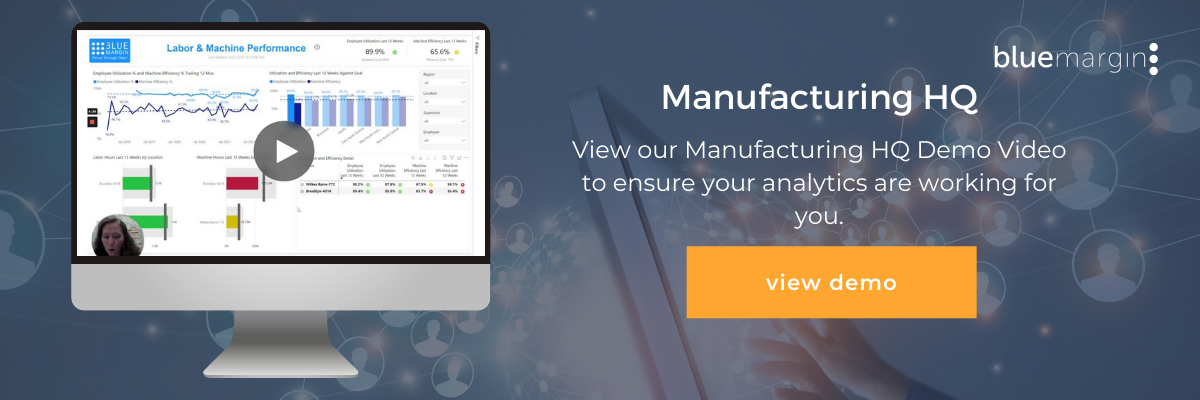Article summary: Learn how to use data optimization strategies and business intelligence to address trends in the manufacturing industry.
Three major trends in the global business environment (in terms of business intelligence) have emerged as central to the Manufacturing industry as they evolve their operations:
Trend 1 - Increased Agility
When Covid-19 reared its ugly head in the spring of 2020, manufacturing lines across industries and around the globe unexpectedly came to a screeching halt, many of them more than once after false restarts. Such drastic stops in production were inevitably followed by large workforce reductions. According to the U.S. Bureau of Labor Statistics, between January 2020 and January 2021, Manufacturing saw a net loss of roughly 575,000 jobs.[1] But simply getting production lines back up and running would not mean the end of manufacturers’ challenges.
Even once facilities were brought back online, management quickly realized that variables such as demand forecasts and production capacity -- foundational inputs traditionally relied upon for planning purposes -- had been rendered unreliable by the ever-changing global economic landscape brought on by the pandemic.
In response, manufacturers have had to become more agile in their production. Unable to plan with 100% certainty, they have found ways to quickly ramp up or down in response to unexpected fluctuations in supply chain, demand forecasts, or production capacity.
In 2021, the only thing we can be certain of is continued uncertainty. Manufacturing leaders must assimilate to this “new normal” if they hope to remain in business. Embracing such uncertainty means letting go of manufacturing’s long-held reliance on planning and instead building agile, responsive operations.
Data Optimization Strategies for Manufacturing:
1- Leveraging data through tools
Now more than ever, insight into your operations is crucial. By leveraging data through tools such as Blue Margin’s Manufacturing HQ Dashboards, managers can detect equipment and labor inefficiencies sooner and respond to anomalies faster. Such responsiveness might mean the difference between keeping your production lines running and facing another shutdown.
2- Automate. Automate.
Industry 4.0 is the term used to define the fourth wave of the Industrial Revolution, denoted by the concept of Automation. Even before Covid-19, manufacturing teams were finding new ways to apply automation technologies including machine learning, robotics, sensors, and artificial intelligence, all with the goal of improving efficiency and quality.
This revolution, which was slowly adopted across manufacturing prior to the pandemic, has now been fast-tracked out of necessity. Automation has become imperative for those who want to remain in business. The foundation of such automation is of course, data. Understanding your operational data and data roadmap is crucial to leveraging today’s automation technology and making your operations as efficient and agile as possible.
Trend 2 - Onshoring of Jobs
Prior to 2020, U.S. manufacturing began seeing a reversal in the offshoring trend that permeated the industry in the 1990’s and early 2000’s. In more recent years, preferred offshoring regions such as China and India have experienced substantial economic improvement which has increased the local cost of labor and, in turn, reduced the attractiveness for U.S. companies to use those workforces. Compounded by offshore quality issues as well as political and social pressure to invest in American jobs, many manufacturers have been bringing work back to the U.S. According to Supply Chain Management Review, “between 2010 and 2018, 749,000 jobs were brought back to the U.S. across 2,900-plus companies as a result of reshoring.”[2]
With the arrival of the Covid-19 pandemic, this onshoring or “reshoring” trend has only increased. In addition to financial and social reasons, it has also become logistically beneficial to repatriate such work. Doing so eliminates numerous headaches caused by an unstable global economy and government hurdles such as foreign trade agreements. Reshoring simplifies logistics by reducing dependency on shipping companies who may encounter unexpected service interruptions or increased costs. Beyond simply reshoring to the U.S, many manufacturers are even adopting a “near-sourcing” strategy where suppliers are chosen specifically for their proximity to the location where finished goods are produced. This has the added benefit of improving local job markets.
Through the process of onshoring and near-sourcing, manufacturers are finding that higher costs are usually recovered via savings from simplified logistics. Often, manufacturers can even justify higher prices as consumers become more appreciative of - even seeking out - locally-sourced products.
Data Optimization Strategies for Manufacturing:
1- Stay on top of your supply chain costs
Keep track of your supply chain costs using Manufacturing HQ’s Accounts Payable Savings dashboard. Combined with your Revenue dashboard, regular assessment of these metrics can help you decide between offshore suppliers with low material costs but higher total cost, versus a local supplier whose higher material cost is offset by less shipping costs and greater reliability.
2- Build a Digital Supply Network (DSN)
Just as you want to leverage digital technology to increase your agility, you can use the same technology to build a Digital Supply Network (DSN). Use your DSN to create a full “digital twin” - an entire digital copy of your supply chain. This digital model allows you to simulate different scenarios and draw key insights from your supply chain’s “behavior.” You can also use your digital twin to create a decision framework around various potential fluctuations in your network, preparing yourself to make crucial decisions about your offshore and onshore supply chain.
Trend 3 - Focus on the Customer Experience
As influential as price and quality, B2Cs have long understood the impact that customer experience (CX) has on a consumer’s buying decision. More recently, B2B buyers are taking the customer-centric experience they enjoy as consumers and are giving it equal value in their B2B dealings. Savvy manufacturers are getting ahead of this trend before such a focus on CX becomes the standard, using it as a key competitive advantage. Those firms who are investing in CX see it as an opportunity to go above and beyond, to “surprise and delight” customers which, in turn, is winning them new and recurring business.
During these times of economic uncertainty, business buyers have become even more discerning about who they buy from, meaning this increased focus on CX will continue. Often expressed as “the ease of doing business,” buyers want to work with companies who offer a streamlined digital experience similar to what they expect as consumers.
For example, you might have a quality product, but do you provide your customer with real-time updates about the status of their order? If they need to make a change to their order, can your customer easily get a hold of Customer Service? Are those changes correctly routed from Customer Service to your production floor? Once the product has been delivered, do you follow up with the customer to check on their satisfaction?
The good news is, you likely already have at your disposal the tools and information needed in order to deliver an exceptional customer experience. All you have to do is make sure you’re tapping into those resources.
Data Optimization Strategies for Manufacturing:
1- Evaluate the entire customer journey
Evaluate the entire customer journey, from order to delivery to post-delivery support. Understand every touchpoint your customer has with your brand, your product, and your service. Of course, the customer journey spans well beyond the bounds of Manufacturing, but it is critical that you understand where and how your operations fit into the overall customer experience. Partner with leadership in other business units such as Marketing, Support, and Customer Service, to review key customer data and gain critical insight into the overall customer journey.
2- Use data to identify opportunities to improve your customer’s experience,
Keep an eye on delivery with metrics such as Customer Fill Rate. Use this information to identify opportunities to improve your customer’s experience, whether that be with the implementation of real-time order status updates or improved delivery time, your customer will be delighted by the extra level of care you have shown.
3- Leverage sources of customer data
Leverage all sources of customer data and integrate them with operational data to create a complete picture. If your organization has a Customer Relationship Management (CRM) system in place such as Salesforce.com, consider integrating it with your Enterprise Resource Planning (ERP) platform and with your Power BI dashboards. Evaluate your manufacturing data along with key customer indices such as Customer Satisfaction (CSat) and Net Promoter Score (NPS), which will provide you with actionable cross-functional insight about your customer’s entire experience.
When manufacturing thrives, America does too.
Talk to Blue Margin about how you can stay ahead of these and other trends in a matter of weeks by leveraging your company’s existing data.
Blue Margin is proud to help mid-market manufacturers develop an HQ that supports their specific goals and value-creation model. Manufacturing leaders who harness their data gain a competitive advantage that leads to increased margins. When manufacturing thrives, America does too.
For Further Reading:
How Manufacturing Uses Dashboards To Increase Profitability - According to Deloitte, data-dashboard insights are a strategic necessity.
3 Unexpected KPIs that Drive Manufacturing Success - Looking for new ideas for tracking real progress at your company? Check out these three unexpected KPIs that drive manufacturing success.
Three Key Thoughts:
“In 2021, the only thing we can be certain of is continued uncertainty. Manufacturing leaders must assimilate to this ‘new normal’ if they hope to remain in business.”
“Reshoring simplifies logistics by reducing dependency on shipping companies who may encounter unexpected service interruptions or increased costs.”
“Often expressed as ‘the ease of doing business’ with a company, buyers want to work with companies who offer a streamlined digital experience like the one they have come to expect as consumers.”
Sources:
- com, “What Is Digital Supply Chain Management?” by Kim Johnson, January 29, 2019, https://www.bitsight.com/blog/what-is-digital-supply-chain-management
- Deloitte, “2021 Manufacturing Industry Outlook,” https://www2.deloitte.com/us/en/pages/energy-and-resources/articles/manufacturing-industry-outlook.html
- Harvard Business Review, “How Smart, Connected Products Are Transforming Competition,” by Michael E. Porter and James E. Heppelmann, November 2016. https://hbr.org/2014/11/how-smart-connected-products-are-transforming-competition
- com, “Offshoring & Reshoring Trends,” Volume 19, Issue 3, September 19, 2016, https://industrytoday.com/offshoring-reshoring-trends/
- com, “Offshore Manufacturing Trends for Mid-Market Companies,” by Amar Shah and Danielle Moushon, October 14, 2014, https://www.industryweek.com/the-economy/article/21963864/offshore-manufacturing-trends-for-midmarket-companies
- Supply Chain Management Review, “Reshoring: COVID-19’s Impact on the Supply Chain,” June 10, 2020. https://www.scmr.com/article/reshoring_covid_19s_impact_on_the_supply_chain
- S. Bureau of Labor Statistics, Employment change by industry with confidence intervals, January 2021, seasonally adjusted, in thousands, 12-month net change, “Manufacturing,” https://www.bls.gov/ces/







